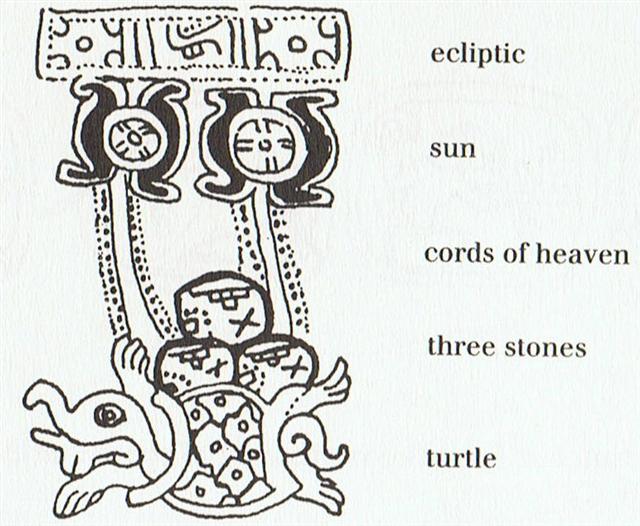7. Another constellation to consider is Orion:
Tautoru (3 stones, The Belt of Orion) could correspond to Nga Kope Ririva, the youths who are 'standing in the water'. Tautoru is just below the celestial equator, i.e. down in the water if the southern hemisphere is regarded as 'water'. The Maya indians thought these 3 stars (stones) were set up as a fire place. Moreover, they regarded this fire place to be resting on a turtle:
As always with Maya pictures (this one is from Maya Cosmos) we must remember to reverse them, south of the equator east is to the right (if you stand with your back towards the south). The front side (summer, spring) in the picture is at left and the back side (winter, autumn) is at right. I have not reversed it because then the English text would have been unreadable. The similarity between the main stars in the Orion constellation and the 3 + 0 + 3 stones in the Pleiades is striking, once you have noticed it:
In Orion there are also 2 oppositely oriented triads of stars, like legs:
But in Orion there is no missing star between the 'knees', because there lies Alnilam: "Alnilam, Anilam, Ainilam, and Alnihan are from Al Nithām, or Al Nathm, the String of Pearls, or, as Recorde said, the Bullions set in the middle of Orion's Belt. It portended fleeting public honors to those born under its influence. The spectrum is Sirian, and the star recedes from us at the rate of about 16½ miles a second. It is the central one of the Belt, culminating on the 25th of January." (Allen) "Bullion ... precious metal in the mass ... Rom. *bulliōnem boiling, f. L. bullīre boil ..." (English Etymology) It makes sense. If fire (Sun) comes in contact with water the result will be boiling. The Belt of Orion and the Mayan turtle lie at the celestial equator, where 'sea' adjoins 'land'. Boiling causes everything to churn around and what is at bottom will suddenly be on the surface (one of the few instances when the force of gravitation is overruled). Sirius was thought of as a very special star in ancient Egypt, not only because it seemed to stand still over the eons, and not only because it was the brightest star in the sky, but most of all because it apparently caused the water of the Nile to rise. Its effects on water was far reaching: "... Pliny wants to assure us that 'the whole sea is conscious of the rise of that star, as is most clearly seen in the Dardanelles, for sea-weed and fishes float on the surface, and everything is turned up from the bottom'. He also remarks that at the rising of the Dog-Star the wine in the cellars begins to stir up and that the still waters move ..." (Hamlet's Mill) When the explorers encountered the turtle, she was on her way up on land. The time should have been beyond spring equinox when 'land' (the sky dome) is rising up, when the bluemarked constellations have begun to rise above the horizon and be visible (as viewed from Egypt):
Taurus is blackmarked, i.e. it is visible already earlier, and depicted as a bull tumbling down. Below is the bluemarked Orion giant, and at his left is the pole with a perching bird on top, summer solstice where a new 'fire' should be ignited because the old one is finished. When the turtle lies her eggs in the sand her purpose is to begin a new cycle of life, and the time should be close to that of the bird between Orion and the pole. Because it is a rechyt, the bird who is flapping her wing as if injured in order to protect her eggs, and she is recognizable from the forward feather sign on her head. Below her wing we can see what looks like an egg, a sign quite similar to one of those balls in the maitaki glyph type:
20 Hanga Hoonu is located in this season too, because 'yesterday' it was 19 Taharoa, when Sun was starting on his voyage of great descent, and a new Sun (a new fire generation) is therefore needed:
The 3 mountain tops at the eastern corner of Easter Island should represent the season of high summer and recreation (worthy of 9 musketry salvos) and Nga Kope Ririva, the opposite pole, should represent the low sky winter season. |
|||||||||||||||||||||||||||||||||||||||





